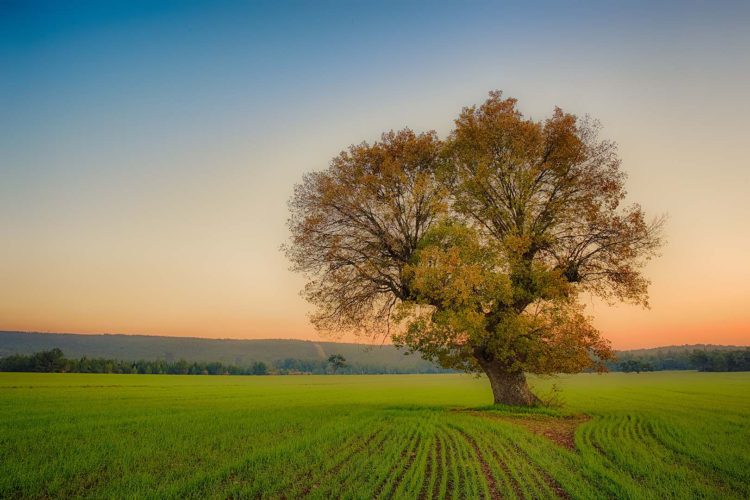Have you ever been driving along out in rural areas and seen just one lone tree in a field? If so, you’ve likely wondered why it was there at all.
Why leave one lone tree in the field, surrounded by crops? This tree is likely something that has been around for half a century or more. It’s a legend. So, you’re thinking perhaps someone didn’t have the heart to uproot it.
But that’s not it at all. The reason you’ll see one lone tree in a field is because it is a source of shade. And it’s tradition.
Farmers in the olden days didn’t have tractors with covered cabs. It was a source of shade from the unrelenting sun, perfect for taking breaks.
The animals also used the shade, hiding out under the branches to get relief from the sun. Since they pulled these old tractors, it was a natural spot to congregate for man and animal in the field.
Some say it helps with bats. Others say there’s sentiment involved. But if you want to know the real reason there’s one lone tree in the field, keep reading!
Why 1 lone tree in the field?
While there are many reasons you may see one lone tree in a field, most people can agree that that single tree serves as a source of shade for farmers and livestock. Out in the field far from the farm house, it makes sense to have a spot to seek cover from the sun under the leafy branches.
If you’ve been wondering why fields have trees in the middle, it’s for more than aesthetics. Though it does look beautiful, the perfect photo opp or place to picnic.
In the USA, the Midwest is full of farm lands that have one tree standing proudly in the center of it all. It’s a symbol of the past, one that has stood longer than any of us here today and will likely be there once we’re gone.
Back in the olden days, lumber was expensive too. So it certainly causes one to pause and wonder why they’d leave one tree up.
Naturally, it provided shade in an otherwise open field. This is why many people say you’ll see one lone tree in a field. It’s for the farmer and livestock to find shade.
Other say it may be to let bats have a place to stay. Bats are natural pest control and are good creatures to have on your land.
But it could be sentimental too, a place where the original owner asked his wife to marry him. Or to mark a burial plot of a loved one.
While there are many reasons for leaving a lone tree in a field, there is one thing you can cross off that list.
That one solitary tree was not left for shelter from a thunderstorm. Never hide under a tree when a thunderstorm comes around. That and being out in the open are the worst places to be.
Why do farmers plant trees along the edges of their fields?
Something else you’ll see are trees lining the edge of farming fields. Why are those there?
Trees and shrubs are often planted along the edges of fields, especially if they sit along a body of water. This can help stop nutrient loss from the fields either by filtering out or absorbing nutrients before getting to the water.
When farmers add nutrients such as chemical fertilizers or manure, this gives the crops the necessary phosphorous and nitrogen to help produce the foods they grow for us to eat.
But when these things aren’t fully used by those growing crops, they can be lost from the fields. This can lead to negative impacts for air and water quality.
Naturally, this washes away when it rains or when snow melts. It can also leach through the soil and get into the groundwater.
High levels of these compounds can cause dead zones that kill fish and destroy aquatic environments. It’s not just bad news for animals.
It’s bad news for people too because these excess compounds can bring about harmful algae blooms that create dangerous toxins.
As such, farmers need to think of smart ways to reduce nutrient losses. Planting trees is one of the best ways to help any farmland.
While we’ve explored why there may be one lone tree in a field, here’s why you may see trees and shrubs planted on the edge of farming lands.
– Helps the soil and reduces erosion
Topsoil erosion can reduce the long-term fertile capabilities of the soil. When the nutrient-rich layer and organic matter are removed, this can easily happen. It’s more common when you have higher rainfall or strong winds.
When farmers plant trees along the edges, it creates a natural barrier that protects both the soil and crops.
These deep-rooted trees make the soil more stable while boosting organic matter from the leaves. That can help improve the soil’s structure while reduce surface water run-off.
– Good for animals
When fields are lined with trees on the perimeter, it can benefit the animals on the land too. Sheltering the fields can help reduce exposure to cold during winter months, which is especially helpful for fields that support lambing.
And for poultry, the tree plantings can get free-range birds to move around the range more. It helps the animals stay more stress-free and improves the quality of the eggs.
For any farm with animals, having trees on the edges can help buffer weather and keep the animals more comfortable. This will make a farmland more productive.
– Keep crops sheltered
When the spring and summer seasons are dry, this can be a disaster for crops. Dry weather causes poor germination and as such, reduces growth rates and bringing with it lower crop yields.
Planting these fields with edges of trees can protect those crops from drought. It changes the microclimate around the crop. This way, wind speed is reduced and wind speed can remove the moisture from the air.
Trees additionally help lengthen the growing season for grass. They create necessary shelter that raises soil temperatures in both early spring and late autumn. It’s a great way to make the grass greener, so to speak, when trying to boost your crop yields.
– Helps water management
Should you only modestly add a tree line around your crops, you can boost water infiltration.
That means the surface water run-off is reduced. And you’ll also decrease the rate at which the flowing rainwater gets to streams, rivers, and lakes.
It can be what saves an area from downstream flooding. Plus, with those chemical compounds on the farm, you can slow any run-off of these things too, making less of an impact on your surroundings.
– Reduction of pollution
Pollution isn’t just bad for the environment. It is costly for farms too. Particularly farms with livestock create ammonia excrement from the urea of the livestock. This ammonia can cause damage to the surrounding habitat and water.
It also impacts the health of the livestock as well as the farmers. With trees, it makes a physical barrier. This barrier can reduce any spray drift while capturing pollutants and ammonia from the livestock.
– Improved energy efficiency
Wood is critical for making fuel. It can be grown on lands that are difficult to farm or it can be harvested from the trees that you plant to give you shelter.
Woodchips can additionally be used to create bedding or replace straw. A mixture of the two gives the best results.
Having trees planted around the perimeter for livestock and farm buildings can boost energy efficiency in the form of shade as well as buffering the winds.
– Creates another revenue stream
Planting trees that edge your habitat can have additional benefits for your income as a farmer. You can line the farmlands with trees that attract game birds.
These birds, like pheasant or partridges seek shelter and use the trees as a source of food. You can use them as a source of revenue too.
Fruits and nuts are another thing you can harvest from these trees. This will make for an additional stream of revenue for any farm.
– Help the bee problem
One of the biggest concerns in the world today is the decline of pollinators. The loss of habitats is one of the most significant causes of this problem.
When you plant more trees, hedges, and plants in shelter belts, this makes for nesting sites, refuges for winter, and proper pollen and nectar feeding sources that can be used year-round.
Additionally, pollinators like bees use these belts of shelter from the trees like humans use highways.
They browse them and then settle on a spot. With regularly-spaced trees, this shelter helps bridge the gap in an otherwise desolate area where they may not find what they are looking for.
We need pollinators to keep our environments thriving and providing them a source on your land can only help your efforts improve.
– Conserve wildlife
More trees means more habitat for wildlife. When you buffer and extend the ancient woodlands with new trees, you bring in more insects.
And while that may sound like something you don’t want, it will bring in birds and other small mammals. As they come in, this draws other species to the land.
With climate change affecting the ranges of a variety of animals, helping bring them into an area where they can thrive is important.
Sure, there will be more bugs, but there will be more birds and more small animals too which can make the land thrive.
A perfect example of this is the bat which eats all the pests and can help the land become more harmonious.
One tree or many?
So, if one tree left lone in a field is good for shelter for animals and humans, and a line of trees is good for the farm, what should you do?
In the center of your field, you can leave one lone tree. It will bring shade for animals and provide a place for bats to live safely.
But having that border of trees on the edge of your land also serves a good purpose. This border can stop the important fertilizers from leaving your land.
It can also prevent that nutrient-rich layer of topsoil from depleting due to rain and wind.
An edging of trees is especially important when your land abuts water. This will slow runoff that can erode your land and cause damage to surrounding waterways and lands. It can impact floods too by slowing water flow and preventing flash flooding.
Ideally, you’ll make use of both tactics as you prepare your land for growth and future harvest.
Conclusion
The reason you see a lone tree in a field of farm land is likely because it served as shelter in the olden days. This shelter was a source of shade from the sun where farmers and the animals that pulled their tractors could take a rest.
It’s also aesthetically-pleasing, but the reason you see it is for more than just a beautiful photo opportunity. As such, you’ll also see trees lining farmlands too which serves additional purposes.
Trees are beneficial to farmers in so many ways. They offer another source of income from growing fruits and nuts, shade for animals, protection for the surrounding environment as well as the farm, and much more.
While it may seem like extra work to add trees to the edge of your farm, taking this step can further boost profits for farmers, add a defined border to the farmland, and prevent environmental problems from causing profits to dwindle.

